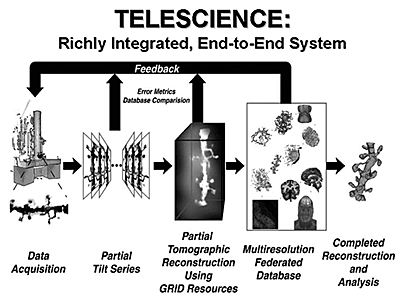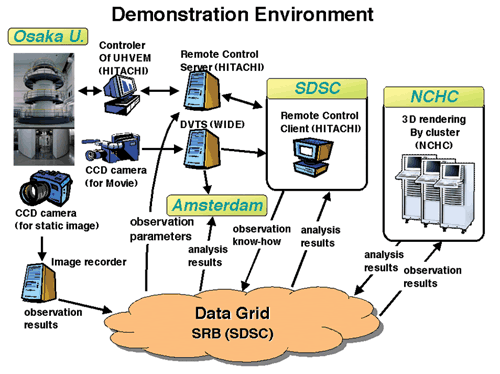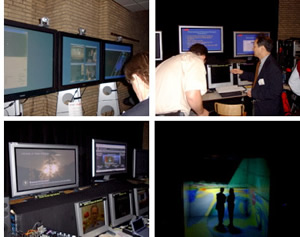| The research and development (R&D) conducted by the Remote Data Collection
System Group is one of Grid technologies, of which standards are being established
in the GGF, and is referred
to as a "collaboration and remote installment service." Since there
has not been much investigation into this type of technological development, interesting
evolution is expected in the research conducted by the group. |
| This group aims at achieving remote use of high-performance and rare observation
equipment connected to the Grid environment, for example Research Center for Ultra-High
Voltage Electron Microscopy, Osaka Univ. and SPring-8, a large light-emitting
facility, as well as building the Grid architecture and infrastructure for sharing
and analyzing various information globally collected by ubiquitous robots. Conventionally,
this type of observation data has not been shared among researchers. In this project,
researchers share and analyze data for deeper insight into their own themes, and
individual database systems will then be integrated into a large-scale data grid
system. This will contribute to smooth acquisition of new knowledge. |
| 1. Remote use of the ultra-high voltage electron microscopy | |
| R&D on the remote use of the ultra-high voltage electron microscope
is being conducted in collaboration with San Diego Supercomputing Center and the
University of California, San Diego (UCSD) and that on its visualization technology
is in collaboration with the
National Center for High Performance Computing (Taiwan). The concept of this R&D referred to as "Telescience Portal", which enables the remote operation of the ultra-high voltage electron microscopy and shares digitalized observation data among researchers is proposed by Prof. Mark Elisman, a neurophysiological scholar in the US. This can be said to be the most Grid-like application from the perspective of data being globally transferred on IPv6 lines. |
 |
 |
Description of architecture schematic: Images are taken through CCD camera connected to ultra-high voltage electron microscopy →real-time information delivered to researchers via Internet →researchers indicate the desired camera angles → images are accumulated by rotating static camera → accumulated image data transferred to static image server (referred to as SRB: underlying technology for data sharing middleware enabling an environment where data from Osaka Univ. can be shared on the Grid system) → the system can be operated remotely from the San Diego Center and data can be proceeded on plural number of computers in the distributed mode. |
| 2. SPring-8: Diversion to SPring-8, the X-ray Remote Observation System |
| The system built by the ultra-high electron voltage microscopy can be diverted
to SPring-8. First of all, the external connection is leveled up to the Giga level,
then improve network performance. |
|
 |
| The 2003 plan is described as follows. |
| 1.Integration of SPring-8 Remote Operation System into the Grid system |
| 2.Expansion of Remote Operation System of Ultra-High Voltage Electron Microscope |
|
| Appendix: Introduction of ECO GRID (Taiwan NCHC) |
| The ECO GRID project aims at building a Grid environment for supporting ecological research using radars and sensors. In this environment, we will expand our framework of online data collection. |
| Top | Project | Research work | Archive | Event | Link | |